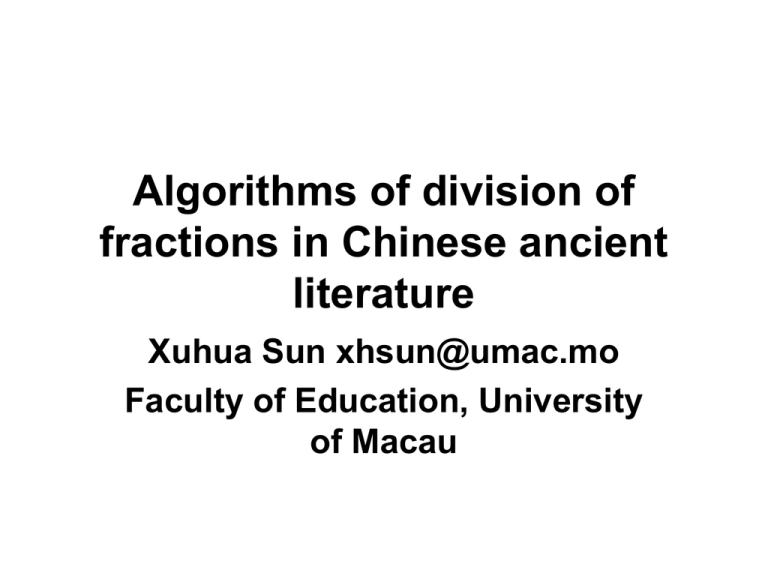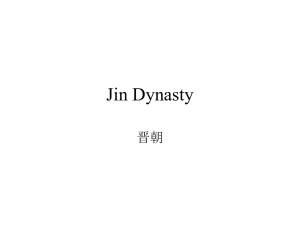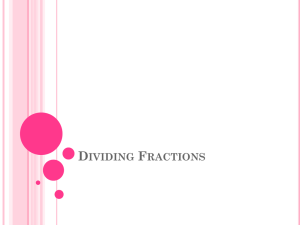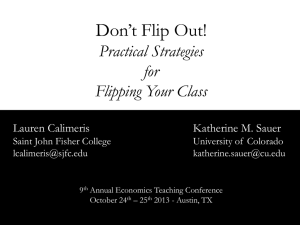Document
advertisement

Algorithms of division of fractions in Chinese ancient literature Xuhua Sun xhsun@umac.mo Faculty of Education, University of Macau 自我介紹 • 1991.6 东北师范大学数学专业本科毕业, 获理学学士学位/硕士学位 • 1994. 9- 2003,广州师范学院 \广州大学副 教授 • 2003,1—2006,12 香港中文大学教育学 院 博士 • 2006-2007 香港教育学院 研究员 • 2008 –now 澳门大学 助理教授 Does calculation of fraction division mean the procedure of “flip and multiply”? • Is historical research a powerful tool in mathematics teaching. Who could explain why the algorithm of “flip and multiply” work well ? 3 3 3 8 2 4 8 4 3 • The six US textbooks provided the idea of reciprocal and “flip-and-multiply” algorithms for fraction division only , but did not explain why the procedure works (Li 2009). • American pre-service and in-service teachers experienced difficulty in making a conceptual explanation for the underlying principle and meaning of “flip and multiply”(e.g., Ball, 1990; Ma, 1999; Li, 2008; Li & Kulm, 2008). A typical mistake was: “flip both dividend and divisor”. Background • My PHD thesis • Division of fractions is often considered the most mechanical and least understood topic in schools. • A range of studies have repeatedly shown that both teachers and students have difficulty in making a conceptual explanation for the traditional algorithm of “flip and multiply”. Two ways “flip and multiply” reducing to same denominat or 3 3 3 8 2 4 3 4 8 3 3 3 2 3 6 3 63 2 4 8 4 2 8 8 8 Suan Shu Shu • Suan Shu Shu 《算数书》was the oldest book on mathematics. • It was written from 202 B.C. to 186 B.C., or more than 300 years earlier than Jiu Zhang Sun Shu《九章算术》. Algorithm of Division of Fractions in Suan Shu Shu • 启从。广7分步之3,求田4分步之2,为从 (纵)几何?其从(纵)1步6分步之1。 • 求从(纵)术:广分子乘积分母为法,积 分子乘广分母为实,实如法一。 Procedure 2 3 2 7 14 1 1 4 7 4 3 12 6 • The another problem and procedure is as follows: 1 1 23 (3 ) 5 (18 3 2) (5 6) 2 3 30 . The underlying rationale of “flip and multiply” algorithm • “Deleting denominator” possibly indicates an underlying principle to solve problems of fraction. • The divisor and dividend become integers after being multiplied by the same number and the quotient is not changed • This underlying principle should help to understanding the reason . Nine chapters Algorithm of Division of Fractions in Nine chapter • 经分,又有三人,三分人之一,分六钱三 分钱之一,四分钱之三。问人得几何? 答曰:人得二钱、八分钱之一。经分术曰: 以人数为法,钱数为实,实如法而一。有 分者通之,重有分者同而通之. Reducing to same denominator 1 3 1 19 3 10 85 40 85 1 (6 ) 3 ( ) 2 3 4 3 3 4 3 12 12 40 8 Besides, Liu Hui added a new solution, namely, flip multiplication (See Bai, 1983). 1 3 1 19 3 10 85 10 85 3 1 (6 ) 3 ( ) 2 3 4 3 3 4 3 12 3 12 10 8 Algorithms of Division of Fraction in Shu Li Jing Yun (《数 理精蕴》) • Shuli jingyun directly illustrated • the algorithm of “numerator dividing numerator and denominator dividing denominator. • . 2 1 9 3 = . = 2 1 2 93 3 • “Reductions of fractions to the same denominator” was also regarded as that the only algorithm illustrating the principle of fraction division, namely, two numerators are in proportion (the same proportionate fraction unit is deleted). “Reducing to same denominator” • This algorithm makes up some weakness of “flip and multiply”. • Link to experiences of whole-number division and that of fraction addition / subtraction. • Procedure of “flip and multiply” is based on rod numerals system Greece -- Geometry/ Euclid Theorem-based tradition Algebra Analytic geometry Calculus Two traditions of mathematics and Arithmetic Euclid’s Elements is printed [1482] 1200 1300 1400 1500 1600 1700 1800 1900 2000 Arithmetic 1677 E. Cocker Babylonian, Egyptian, Chinese, Indian… Problem-based tradition 1738 Euler: Introduction to the Art of Arithmetic [1202] Fibonacci’s Liber Abaci (The Book of Calculation) first appears • Thank you!











